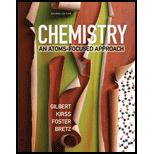
To find:
a. Assign oxidation numbers and find out how many electrons are involved in process.
b. Calculate
c. Calculate
d. Determine the effect of
e. Assign oxidation numbers and the electrons involved in the process.
Answer to Problem 17.97QA
Solution:
a.
b.
c.
d. The value of
e.
Explanation of Solution
1) Concept:
We are given a
The enthalpy of the reaction is the difference between the total enthalpy of formation of products and the total enthalpy of formation of reactants.
Using the equation below and using the standard enthalpy formation values of reactants and products in a given reaction,
Electric work is the product of the quantity of charge flowing and the cell potential of the cell. It is given that
We know that the Gibbs free energy can be calculated by using the formula
Now, we are considering the value of entropy of the reaction, and it is given that it is greater than zero. This implies that the entropy has a positive value, and when put in the equation, the
We also know that the Gibbs free energy is directly proportional to the cell potential of the cell. Thus, if the value of Gibbs free energy is increased, the cell potential will also increase significantly.
2) Formula:
i)
ii)
iii)
3) Given:
i)
ii)
iii)
iv)
v) Faraday’s Constant
4) Calculations:
a. Assigning oxidation numbers for each of the element in the given equation:
Given balanced redox reaction is
In
Therefore, oxidation state of
In
Therefore, the oxidation state of
In
In
Fluorine is present in elemental form in
Thus we can see that
b. The enthalpy of a reaction can be calculated by the following formula
We have already been given the
The given chemical equation is
We will put the given values of enthalpy of formation in the formula, which is written as
Thus, the enthalpy of the reaction is
c. Estimating
Gibbs free energy is calculated by two formulas; one involving enthalpy and entropy of a reaction, and the other one involving cell potential. The formulae for both are shown below:
Since for this reaction, it is assumed that
We have calculated the enthalpy of the reaction, and we also know the number of electrons being transferred. Therefore, we can find out the cell potential.
By the formula above,
Thus, the cell potential of the given reaction is
d. We know that the Gibbs free energy can be calculated by using the formula
Now, we are considering the value of entropy of the reaction, and it is given that it is greater than zero. This implies that the entropy has a positive value, and when put in the equation, the product
We also know that the Gibbs free energy is directly proportional to the cell potential of the cell. Thus if the value of Gibbs free energy is increased, the cell potential will also increase significantly.
Therefore, the value of cell potential
e. Assigning O.N. to each element for the given reaction:
The given reaction is
In
In
Now,
Conclusion:
If we can assign the oxidation numbers correctly, we can easily find out which species is undergoing reduction or oxidation and by how many electrons, without the need of half-reactions of the redox reaction.
Want to see more full solutions like this?
Chapter 17 Solutions
CHEMISTRY:ATOMS-FOCUSED..-ACCESS
 ChemistryChemistryISBN:9781305957404Author:Steven S. Zumdahl, Susan A. Zumdahl, Donald J. DeCostePublisher:Cengage Learning
ChemistryChemistryISBN:9781305957404Author:Steven S. Zumdahl, Susan A. Zumdahl, Donald J. DeCostePublisher:Cengage Learning ChemistryChemistryISBN:9781259911156Author:Raymond Chang Dr., Jason Overby ProfessorPublisher:McGraw-Hill Education
ChemistryChemistryISBN:9781259911156Author:Raymond Chang Dr., Jason Overby ProfessorPublisher:McGraw-Hill Education Principles of Instrumental AnalysisChemistryISBN:9781305577213Author:Douglas A. Skoog, F. James Holler, Stanley R. CrouchPublisher:Cengage Learning
Principles of Instrumental AnalysisChemistryISBN:9781305577213Author:Douglas A. Skoog, F. James Holler, Stanley R. CrouchPublisher:Cengage Learning Organic ChemistryChemistryISBN:9780078021558Author:Janice Gorzynski Smith Dr.Publisher:McGraw-Hill Education
Organic ChemistryChemistryISBN:9780078021558Author:Janice Gorzynski Smith Dr.Publisher:McGraw-Hill Education Chemistry: Principles and ReactionsChemistryISBN:9781305079373Author:William L. Masterton, Cecile N. HurleyPublisher:Cengage Learning
Chemistry: Principles and ReactionsChemistryISBN:9781305079373Author:William L. Masterton, Cecile N. HurleyPublisher:Cengage Learning Elementary Principles of Chemical Processes, Bind...ChemistryISBN:9781118431221Author:Richard M. Felder, Ronald W. Rousseau, Lisa G. BullardPublisher:WILEY
Elementary Principles of Chemical Processes, Bind...ChemistryISBN:9781118431221Author:Richard M. Felder, Ronald W. Rousseau, Lisa G. BullardPublisher:WILEY





